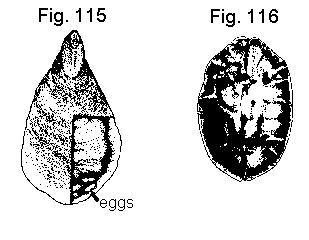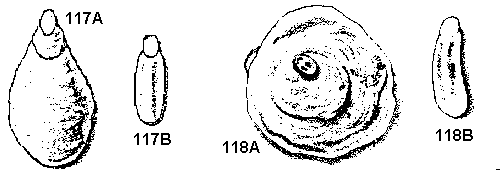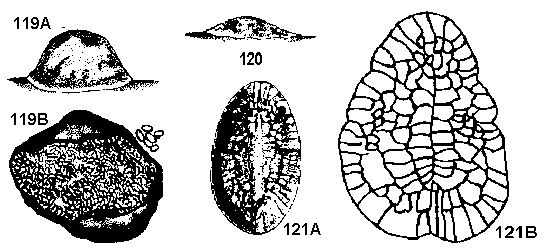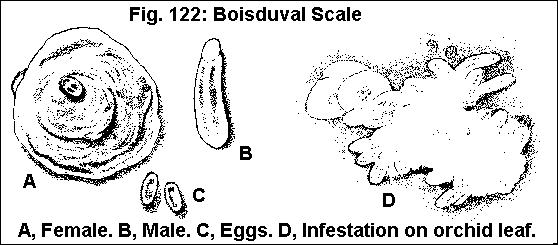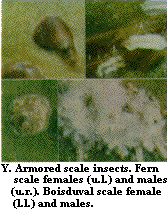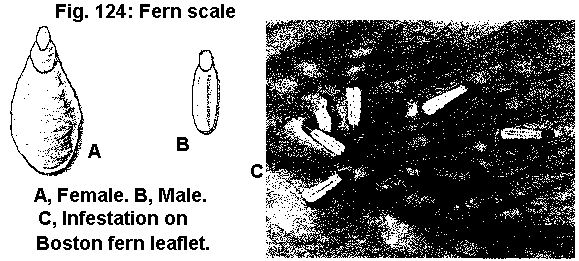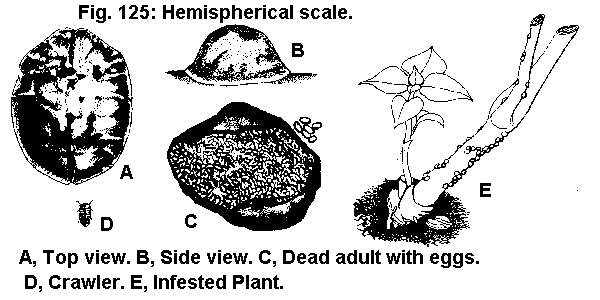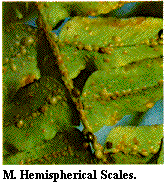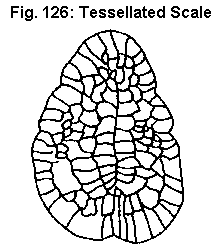Introduction
Scale insects are a diverse group of insects in the order HOMOPTERA. There are about 6,000 species of scale in sects in 21 families worldwide. About 1,000 species occur in North America. The three most common families of scale insects are the armored scale, the soft scale, and the mealybugs. Most of the pest species belong to one of these three families.
Armored Scale Insects
Armored scales are the smallest of scale insects, ranging in size from 1 to 3 mm. The body of the scale insect is protected by a cover (the armor) made from wax secreted by the insect and cast skins (exuviae) of previous growth stages. One must remove the hardened wax cover to expose the body of the insect. The exposed body usually is yellow or orange, but may have a pink or red color to it. This cover also protects the eggs laid by the female. Armored scale insect covers vary from circular to elongate or oystershell-shaped (Figure 115). Male and female covers may differ in size and shape for the same species. The cover of the female is generally largest. Boisduval scale and fern scale are common armored scale insects attacking flowers and foliage plants.
Most armored scale insects reproduce sexually. The eggs hatch beneath the protective scale cover and the first instars, commonly called "crawlers," migrate to the new growth to settle and feed. Armored scale females lose their legs at the first molt and are sessile for the rest of their lives. Females develop through three instars and males develop through five. Armored scales may overwinter as eggs, nymphs, or adult females. Adult males are usually present about two weeks in each generation. Some armored scales have four generations per year.
Soft Scale Insects
Soft scales (Figure 116) differ from armored scales in that they do not secrete a waxy covering that is separate from the body. If wax is present, it adheres tightly to the body of the female and cannot be easily separated from it. Most soft scales produce a thin, glassy wax that does not obscure the color or form of the female soft scale. Soft scales are fairly large (2 to 6 mm long) and can be distinguished by their larger size, round or oval body outline, and convex or hemispherical profile. Soft scale females vary from flat to almost spherical. Often different host plants will alter the body form of a single species so much that taxonomists have described the different forms as separate species. If one turns the adult soft scale over, legs, antennae and thread-like mouthparts are readily visible with the aid of a microscope. Three common soft scales found in greenhouses and interior plantscapes are the brown soft scale, hemispherical scale, and tessellated scale.
Soft scales may reproduce sexually or parthenogenetically and every female may be capable of producing progeny without fertilization. Tremendous populations can develop during a single growing season. Most outdoor species have one generation per year. Females either lay eggs or give live birth, depending on the species. There are three instars in the females and five instars in the males. In warmer climates and in greenhouses, species with multiple generations may have all stages present simultaneously throughout the year.
Key to Scale Insects Found on Flowers and Foliage
- Body of insect protected with a wax or vanish-like covering that is not attached to the body of the insect; the insect can be seen by lifting off this covering (Figure 115) - ARMORED SCALE INSECTS (GO TO 2)
Body of insect oval in top view, bare or covered with a clear glassy-type wax that adheres to the insect's body (Figure 116); infested plants often sticky with honeydew excreted by the insect - SOFT SCALE INSECTS (GO TO 3) -
Scale covering of female brownish and oystershell shaped (Figure 117A); male cover snow-white with three ridges down the back (Figure 117B) - FERN SCALE
Scale covering circular or oval, thin, flat, white to light yellow, semitransparent, and exuviae central or subcentral (Figure 118A); male cover oblong oval, white, also with three ridges down the back (Figure 118B) - BOISDUVAL SCALE
-
Mature individuals noticeably convex or hemispherical in side view (Figure 119A), shiny brown in color; sometimes hundreds of eggs found under the body (Figure 119B) - HEMISPHERICAL SCALE
Mature individuals flat or only slightly convex in side view (Figure 120); yellowish-green to black in color; no eggs found under body although a few crawlers may be present under the female - GO TO 4
-
Body yellowish-green to yellowish-brown in color; often mottled with brown spots (Figure 121A) - BROWN SOFT SCALE
Body oval, opaque, reddish-brown, and 4 to 5 mm in length; the dorsal surface appears checkered or cellular in pattern when examined with a magnifying glass (Figure 121B) - TESSELLATED SCALE
Boisduval Scale
Boisduval scale (Figure 122), Diaspis boisduvali Signoret, Diaspididae, HOMOPTERA
DESCRIPTION
Adult Female
Cover of the adult female boisduval scale is circular or oval, thin, flat, white to light yellow, semitransparent, and 1.2 to 2.25 mm in diameter. Exuviae central to subcentral in position (Figure Y).
Other Stages
The male cover is somewhat rectangular in shape, elongate, about 1 mm in length, and snow white with three ridges down the back.
Eggs
Boisduval scale eggs are oval and pale yellow to pale orange.
Nymphs
Newly settled nymphs are pale orange.
BIOLOGY
Distribution
Boisduval scale attacks orchids and palms in the warmer areas of California and Florida where these hosts are grown extensively. It can be found indoors in all parts of the world and is a common greenhouse pest.
Host Plants
Cattleya and Cymbidium orchids are the most common hosts, but this scale insect thrives on the leaves and bark of other orchids, palms, banana, and cacti.
Damage
New growth is frequently attacked prior to opening, and leaves may be killed if the infestation is dense. Lighter infestations produce irregular chlorotic spots that mark feeding sites and spoil the appearance of the leaves.
Life History
Under greenhouse conditions, boisduval scale can complete its life cycle in about 50 days. Females may produce up to 200 eggs in a lifetime. Eggs hatch in 5 to 7 days and most of the crawlers settle to feed within 24 hours after hatching. The first stage lasts about 10 days, the second about 8 to 10 days for females and 15 for males. After mating, females retain their eggs for a short period, then oviposit. Because females produce eggs over a long period, generations overlap, and usually all stages can be found at any one time. Crawlers can settle anywhere on the leaf, but seem to prefer the midrib and major veins.
CONTROL
Try to purchase plants from a supplier who does not have a scale infestation. When scales are encountered, horticultural oils give adequate control without excessive phytotoxicity. Two thorough treatments two weeks apart should give good control. Boisduval scale crawlers often establish themselves near the base of the plant and in leaf sheaths making control difficult. Also, both upper and lower leaf surfaces are attacked, so thorough coverage of any treatment is essential. For specific control recommendations, see the current Cooperative Extension publications on ornamental plant pest management or consult your county Extension agent.
Brown Soft Scale
Brown soft scale (Figure 123), Coccus hesperidium Linnaeus, Coccidae, HOMOPTERA
DESCRIPTION
Adult
Living adult female brown soft scales are pale yellowish green to yellowish brown, often mottled with brown spots. Older females are brown. the body is usually oval in outline, 2.5 to 4 mm in length and slightly convex in profile (Figure C). The shape tends to vary according to position on the host plant. Males look like tiny two-winged wasps or flies and are rare.
Other Stages
Crawlers and young nymphs are yellow and almost flat in profile. Parasitized nymphs are dark brown to black and convex. Crawlers have well-developed legs and antennae and are quite active until settling. Older nymphs are sessile.
BIOLOGY
Distribution
Brown soft scale is cosmopolitan in tropical and subtropical regions and in greenhouses in northern regions. In North America it occurs out of doors in the deep South, and north along the eastern seaboard to Virginia and as far north as southern Vancouver island on the West Coast.
Host Plants
Brown soft scale has been reported feeding on hundreds of different plants. It can survive on most greenhouse plants, but seems to prefer perennials over annuals. Ferns are a favored host.
Damage
Brown soft scale is probably the most frequently encountered scale on plants indoors. Infestations of brown soft scale can become so heavy as to encrust the stems and petioles of their host plant. They also settle on leaves, usually along midribs and occasionally on the fruit. Large colonies remove large quantities of plant fluids and can cause wilting, but they seldom kill their host. Immatures and adults produce much honey dew that serves as a medium for the growth of sooty molds. These fungi inhibit photosynthesis and make infested plants unsightly. Obnoxious insects such as ants and wasps are also attracted to feed on the honeydew.
Life History
Females are ovoviviparous and retain the eggs in the body until hatching. Brown soft scales are born as active crawlers but remain under the body of the female for a short time before emerging and selecting a feeding site to settle and complete their development. Females molt twice before reaching maturity. Males undergo four molts before emerging as winged adults, but are rarely seen. All stages are found throughout the year in warmer regions and in greenhouses. Brown soft scales can complete three to seven generations per year depending on temperature. It takes about 60 days to complete a generation.
CONTROL
Brown soft scales are surprisingly difficult to control even though there is no external egg stage and only a few very young nymphs are protected by the body of the mother. Although reported as a pest species of many host plants in many countries, outdoors it may be suppressed by natural enemies in many areas. Scutellista cyanea Motschulsky is a common parasite and Metaphyous luteolus Timberlake controls brown soft scale in California. For specific chemical control recommendations, see current Cooperative Extension publications on ornamental plant pest management or consult your county Extension agent.
Fern Scale
Fern scale (Figure 124), Pinnaspis aspidistrae (Signoret), Diaspididae, HOMOPTERA
DESCRIPTION
Adult
Female fern scale armor is oystershell or pear shaped, flat, light brown with the crawler cast skin a paler brown. Sometimes the second stage armor is also paler than the adult armor. They are 1.5 to 2.5 mm long. The male armor is white felted, three-ridged, and the crawler cast skin is beige to yellowish brown. Adult males are tiny, two winged, gnatlike insects that are easily overlooked (Figure Y).
Egg
Eggs of armored scales are usually oval and about 0.2 mm long. They are laid in groups under the female armor.
Crawler
Fern scale crawlers are about 0.2 mm long, flat, and yellow with red eyes. The legs and antennae are well developed.
Nymph
Female second-stage nymphs secrete an oval, pale brown armor about 0.8 mm long. Male second stage nymphs secrete a white armor which has three long ridges. Mature male second stage nymphs are about 1 mm long.
BIOLOGY
Distribution
Fern scales are found on ferns in greenhouses and homes, and they are found outdoors on liriope in the Coastal Plain and Piedmont of the Southeast.
Host Plant
Fern scales mainly infest true ferns (not asparagus ferns) and liriope. This pest has been recorded from numerous foliage plants, citrus, and other woody ornamental trees and shrubs in Florida.
Damage
Infested ferns are disfigured by the presence of male second stage armor, which is conspicuous against the dark green foliage. Ferns in commercial production sometimes tolerate a tremendous scale population with little noticeable reduction in vigor or color. Feeding by female scales causes yellow spots on some fern varieties and on liriope. Males do not feed beyond the second stage of development.
Life History
Little is known about the biology of fern scales specifically. Female scales lay their eggs under the armor. The female dies after the last egg is laid. Tiny crawlers hatch from the eggs and eventually emerge from under the mother's armor. The crawlers move about until they begin to feed by inserting their long, threadlike mouthparts into the leaf and sucking out nutrients. The insect molts into a second stage which begins to secrete a waxy material from under the rear of the first stage (crawler) cast skin. Eventually these insects molt into the adult stage. Female scales begin to secrete the adult armor at the rear of the second stage armor. Males emerge from their second stage armor as tiny, gnatlike insects that crawl or fly to female scales to mate. The armor remains fastened to the plant long after the scale insect leaves (male) or dies inside (female). When populations become dense, females tend to lay male eggs so that heavily infested plants become conspicuously spotted by second stage male armor.
CONTROL
Try to purchase plants from a supplier who does not have a fern scale infestation. When fern scales are encountered, horticultural oils give adequate control without excessive phytotoxicity to ferns. Two thorough treatments two weeks apart should give good control. Ferns are notoriously sensitive to pesticides. Whenever treating ferns and other sensitive plants, treat at a time that the pesticide will be dry on the foliage before the plants are exposed to full sunlight. For specific chemical control recommendations, see current Cooperative Extension publications on ornamental plant pest management or consult your county Extension agent.
Hemispherical Scale
Hemispherical scale (Figure 125), Saissetia coffeae (Walker), Coccidae, HOMOPTERA
DESCRIPTION
Adult
Depending on the host plant, the adult scale may vary in size. The scale varies from 4.5 mm on Cycas to as small as 2.0 mm on asparagus fern. Relatively hemispherical, brown, smooth, and shiny, the scale may resemble a miniature army helmet (Figure M). Young females may have a pattern of ridges in the form of the letter "H" on the dorsal surface.
Egg
The oblong, pinkish beige eggs are about 0.7 mm long and are protected by the mother's body in a mass of hundreds.
Crawler
The flat, pinkish beige crawler is about 1.0 mm long with two red eye spots. The antennae and legs are short and spindly. There are two setae protruding from the rear.
Nymph
Nymphs are semitransparent, light yellow or fig! pink, and flat (young) to humped (older). They are so closely attached to the host plant that the legs and antennae are concealed. Two pale lines start at the margin on each side and fade in intensity toward the middle. Nymphs and young adults may exhibit the characteristic "H" pattern of the black scale group.
BIOLOGY
Distribution
From its probable origin in South America, the hemispherical scale insect is now found in greenhouses and interiorscapes throughout the United States.
Host Plants
The hemispherical scale insect has a wide range of hosts including bamboo, camellia, chrysanthemum, crape myrtle, croton, ferns, figs, gardenia, honeysuckle, lily, orchids, and zamia.
Damage
The secretion of honeydew and subsequent formation of sooty mold detracts from the beauty and commercial value of the plant. Feeding causes the plant to become stunted and lose its leaves.
Life History
The hemispherical scale insect is a tropical insect that has become a common greenhouse pest. In warmer temperate areas, the scale can live outside. Unlike many other scales, the hemispherical scale secretes little wax. However, the scales do produce much honeydew which allows sooty mold to grow. Males are unknown and reproduction is by parthenogenesis. Each female may deposit up to 1,000 eggs. After laying the eggs, the female dies and her body shrinks to form a cup or helmet over the eggs. Development for the egg stage and the three nymphal instars requires at least 40 days and may take as long as 105 days. There may be several generations each year in the greenhouse, with all stages being present at any one time. The nymphs do not move much once they have begun to feed. The hemispherical scale insect has a low rate of parasitism indoors, and it often becomes a serious pest.
CONTROL
Hemispherical scale insects are relatively difficult to control because the eggs and young nymphs are protected by the body of the mother. For specific chemical control recommendations, see the current Cooperative Extension publications on ornamental plant pest management or consult your county Extension agent. The most important parasite of hemispherical scale in the United States is Metaphycus helvolus Compere.
Tessellated Scale
Tessellated scale (Figure 126), Eucalymnatus tessellatus (Signoret), Coccidae, HOMOPTERA
DESCRIPTION
Adult Female
Living adult females are flattened, reddish brown to dark brown, and 4-5 mm in length. The body is usually somewhat oval in outline, with the anterior end angulate and the posterior broadly rounded, but the shape may change due to position on the plant. When viewed under a hand lens or magnifying glass, the dorsal surface of the body has a checkered or cellular pattern, divided by a smooth longitudinal median ridge.
Crawlers
Tessellated scale crawlers are reddish brown, flat, elongate oval, and widest in the middle area of the body.
Nymphs
Settled nymphs are light golden in color, flat, oval, and adhering so closely to the leaf surfaces as to be nearly transparent. Males are unknown.
BIOLOGY
Distribution
Tessellated scale is a tropical species whose original home was probably South America. It has been disseminated by man to all parts of the world on its cultivated hosts. Tessellated scale occurs out-of-doors in Florida, California and most tropical areas, and in greenhouses throughout the world.
Host Plants
Tessellated scale occurs most commonly on palms and several species of Ficus, but it has been found on a wide variety of host plants.
Damage
Tessellated scale is primarily a leaf-infesting soft scale and a greenhouse pest. Heavy infestations weaken the plant but seldom kill it. Infestations are often of economic importance in commercial nurseries whenever pest management programs are neglected.
Life History
One or two generations per year, and in greenhouses generations will overlap. Tessellated scale is parthenogenetic and ovoviviparous, giving birth to living young. Males are unknown.
CONTROL
The parasitic wasp, Metaphycus stanleyi Compere is a natural enemy of tessellated scale. As with other scale insects, tessellated scale is best controlled in the immature stage. For specific chemical control recommendations, see the current Cooperative Extension publications on ornamental plant pest management or consult your county Extension agent.
Publication date: Jan. 1, 1994
AG-136
Other Publications in Insect and Related Pests of Flowers and Foliage Plants
- Aphids Found on Flowers and Foliage
- Beetles Found on Flowers and Foliage
- Bugs Found on Flowers and Foliage
- Caterpillars Found on Flowers and Foliage
- Flies and Maggots Found on Flowers and Foliage
- Leafhoppers Found on Flowers and Foliage
- Mealybugs Found on Flowers and Foliage
- Mites Found on Flowers and Foliage
- Scale Insects Found on Flowers and Foliage
- Slugs and Snails Found on Flowers and Foliage
- Thrips Found on Flowers and Foliage
- Whiteflies Found on Flowers and Foliage
N.C. Cooperative Extension prohibits discrimination and harassment regardless of age, color, disability, family and marital status, gender identity, national origin, political beliefs, race, religion, sex (including pregnancy), sexual orientation and veteran status.

